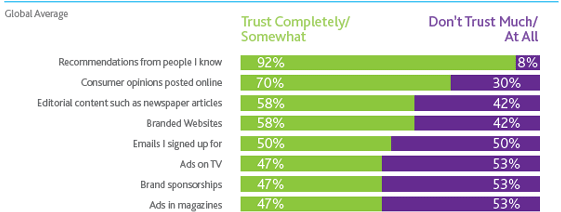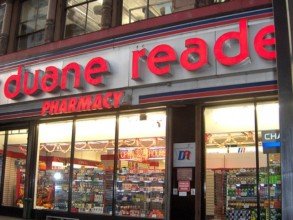“Believe none of what you hear, and only half of what you see”
-Benjamin Franklin
Although the inventor of the lightning rod is often quoted, his advice is rarely heeded. In fact, a recent Neilsen poll suggests that 92% of consumers trust peer recommendations, as opposed to the 58% that trust editorial content or information on branded websites. This means that nearly everybody believes what they hear – which makes word of mouth the most powerful tool at a marketer’s disposal.

Source: Neilsen
Perhaps one of the reasons why people might choose to trust word of mouth recommendations over all others is the lack of apparent commercial motive. The increasing levels of product placement and covert advertising in newspapers and online magazines has reduced people’s trust to the extent that they are no more believable than branded websites, and only 11% more believable than TV or magazine adverts. Put simply, word-of-mouth is social business rocket fuel, but how can you generate it?
Engage Influential Bloggers
Working with local bloggers can be a powerful method for tapping into local networks and reaching new customers, whether you are a small startup or an established corporation. Of course, there needs to be a bit of oversight during the recruitment and engagement processes to ensure that they are going to be the right people to generate your content.

Source: Altaviawatch.com
A recent example of this was a content marketing campaign by US drug store chain Duane Reade, which was aimed at increasing their NYC customer base. This was achieved via localization strategies focusing on user-generated content to reach new audiences. Local bloggers were treated like employeees, being offered incentives and telling them about the marketing initiatives before they were made public. In all, around 2,000 pieces of original content were produced by local bloggers over the course of the campaign.This tactic was hugely successful at amplifying the company message at a local level, resulting in 20 million impressions over the course of the campaign and 28% YOY sales growth.
The same logic can be applied equally to niche industries, where the key influencers may be scattered around the world, but the communities they address are closely connected online. At the corporate end of the scale, companies like Shoedazzle and Beachmint have benefited hugely by cultivating relationships with celebrity tweeters such as Kim Kardashian and Kate Bosworth, mainly because of their huge reach. You don’t need to be a celebrity to have a useful online reach however, so it is worth taking the time to research the most influential and relevant people and cultivate long-term, mutually beneficial relationships with them.
Incentivise your customers with a referral programme
Customers will be much more likely to spread the word about your company if you reward them for referring new customers to them. It can also pay to recognise your most vocal supporters by offering to feature them online with a ‘fan of the week’ blog post or simiilar.
Leverage offline events
Twitter is often used to publicise events, and local ‘Tweetups’ where people who are linked on Twitter meet locally are becoming increasingly popular. Make sure you have your Twitter handle displayed prominently on your website, and always re-tweet positive messages. Also, if there is any criticism of your brand, make sure that you respond to it in an effort to sort out any problems that arise.
Use location-based services
Services such as Google+ Local, which has replaced Google Places, can be very useful for increasing search visibility in local searches. Make sure your business is listed, upload photos and videos, and encourage users to write reviews.
Invite reviews
Online reviews are a powerful way to build trust and engage the community with your brand. Therefore, you should always ask for reviews, as people are much more likely to take the time to do this if you ask them to, and make sure you thank them afterwards.
Build communities using social media
Reach out to your customers and leverage the reach of their combined networks by offering promotions, discounts, and first-looks in exchange for sharing your message. Also, make sure that links to your social communities on Twitter, Facebook, Pinterest etc are prominently displayed in as many places as possible, including your website, stationery and receipts, inside and outside of your business location, and on in-store receipts, storefronts and walls inside your business location, on the sides of your vehicles, and any other advertising.
Search for local hashtags that fit in with your business, such as #LondonEvents or #NewYorkWeddings and include this in your tweets. This will help to build a community of customers, affiliates, and similar local businesses that can retweet and/or mention you, expanding your reach.
To finish off, here’s a very insightful infographic on the topic of Word of Mouth Marketing, courtesy of Column Five and WOMMA:

I am a writer based in London, specialising in finance, trading, investment, and forex. Aside from the articles and content I write for IntelligentHQ, I also write for euroinvestor.com, and I have also written educational trading and investment guides for various websites including tradingquarter.com. Before specialising in finance, I worked as a writer for various digital marketing firms, specialising in online SEO-friendly content. I grew up in Aberdeen, Scotland, and I have an MA in English Literature from the University of Glasgow and I am a lead musician in a band. You can find me on twitter @pmilne100.



























